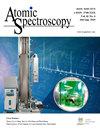微波消解-树脂纯化-双峰MC-ICP-MS法分析环境标准物质的镉同位素
IF 2.3
2区 化学
Q1 SPECTROSCOPY
引用次数: 0
摘要
镉同位素分馏是追踪环境中镉的来源、迁移和转化的一个很有前途的指标;因此,迫切需要一种高精度的环境样品Cd同位素分析方法。在本研究中,八种具有不同基质的环境参考物质(NIST 2711a、GSS-1、GSS-4、GSS-5、GSD-11、GSD-12、GSD-30和BCR679)在微波辐射下被消化,并通过阴离子交换进行纯化。之后,使用具有双尖峰校正的多收集器电感耦合等离子体质谱法(MC-ICP-MS)分析它们的Cd同位素比率。在微波辐射下消化的样品显示出高的Cd回收率(>96%)。基于阴离子交换的纯化一步可以去除大多数干扰元素,而没有任何可检测到的Cd损失。如果纯化溶液中Zn/Cd>0.04、Zr/Cd>0.01、Mo/Cd>0.2、Pd/Cd>4×10、In/Cd>0.02或Sn/Cd>0.1,则需要使用相同纯化程序的第二步。标准物质的δCd测量值(从−0.558‰到0.550‰)与以前的研究结果完全一致,表明该方法可用于分析土壤、沉积物和植物样品中的Cd同位素比率。此外,这些参考物质的Cd同位素比值变化很大,这表明Cd同位素比值有助于识别污染源和Cd的生物地球化学循环。本文章由计算机程序翻译,如有差异,请以英文原文为准。
Cadmium Isotope Analysis Of Environmental Reference Materials Via Microwave Digestion–Resin Purification–Double-Spike MC-ICP-MS
Cadmium isotope fractionation is a promising indicator for tracing the source, transport, and transformation of Cd in the environment; therefore, a high-precision method for the Cd isotope analysis of environmental samples is urgently required. In this study, eight environmental reference materials (NIST 2711a, GSS-1, GSS-4, GSS-5, GSD-11, GSD-12, GSD-30, and BCR679) with different matrices were digested under microwave irradiation and purified via anion exchange. Thereafter, their Cd isotope ratios were analyzed using multi-collector inductively coupled plasma mass spectrometry (MC-ICP-MS) with double-spike correction. The samples digested under microwave irradiation exhibited high Cd recovery (> 96%). One step of anion-exchangebased purification can remove most interfering elements without any detectable loss of Cd. If the purified solution contained Zn/Cd > 0.04, Zr/Cd > 0.01, Mo/Cd > 0.2, Pd/Cd > 4 × 10, In/Cd > 0.02, or Sn/Cd > 0.1, a secondary step using the same purification procedure would be necessary. The measured δCd values of reference materials (from −0.558 to 0.550‰) were in adequate agreement with those of previous studies, suggesting that this method can be used to analyze the Cd isotope ratios in soil, sediment, and plant samples. In addition, the large variation in the Cd isotope ratios of these reference materials implies that the Cd isotope ratio is promising for identifying pollution sources and the biogeochemical cycle of Cd.
求助全文
通过发布文献求助,成功后即可免费获取论文全文。
去求助
来源期刊

Atomic Spectroscopy
物理-光谱学
CiteScore
5.30
自引率
14.70%
发文量
42
审稿时长
4.5 months
期刊介绍:
The ATOMIC SPECTROSCOPY is a peer-reviewed international journal started in 1962 by Dr. Walter Slavin and now is published by Atomic Spectroscopy Press Limited (ASPL). It is intended for the rapid publication of both original articles and review articles in the fields of AAS, AFS, ICP-OES, ICP-MS, GD-MS, TIMS, SIMS, AMS, LIBS, XRF and related techniques. Manuscripts dealing with (i) instrumentation & fundamentals, (ii) methodology development & applications, and (iii) standard reference materials (SRMs) development can be submitted for publication.
 求助内容:
求助内容: 应助结果提醒方式:
应助结果提醒方式:


